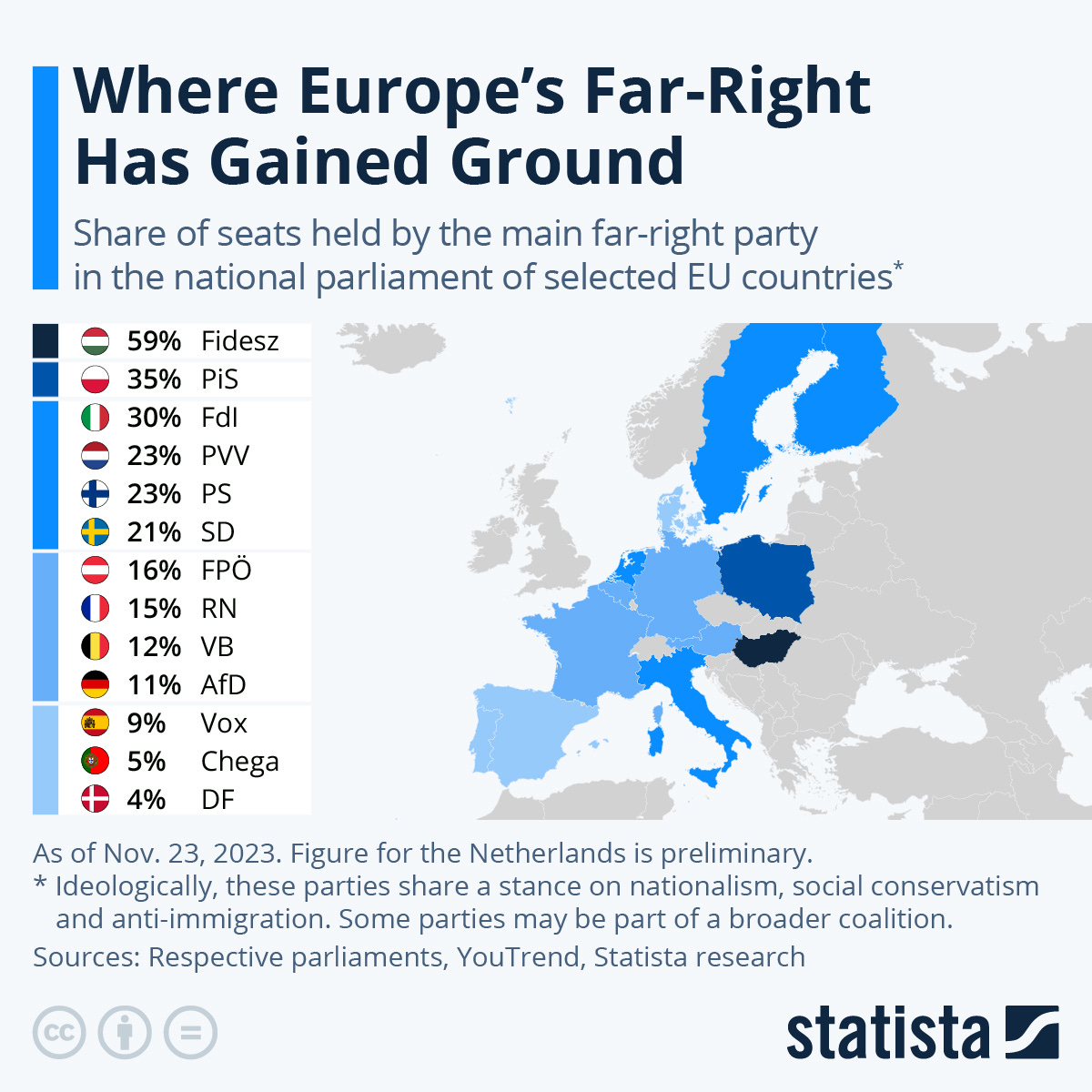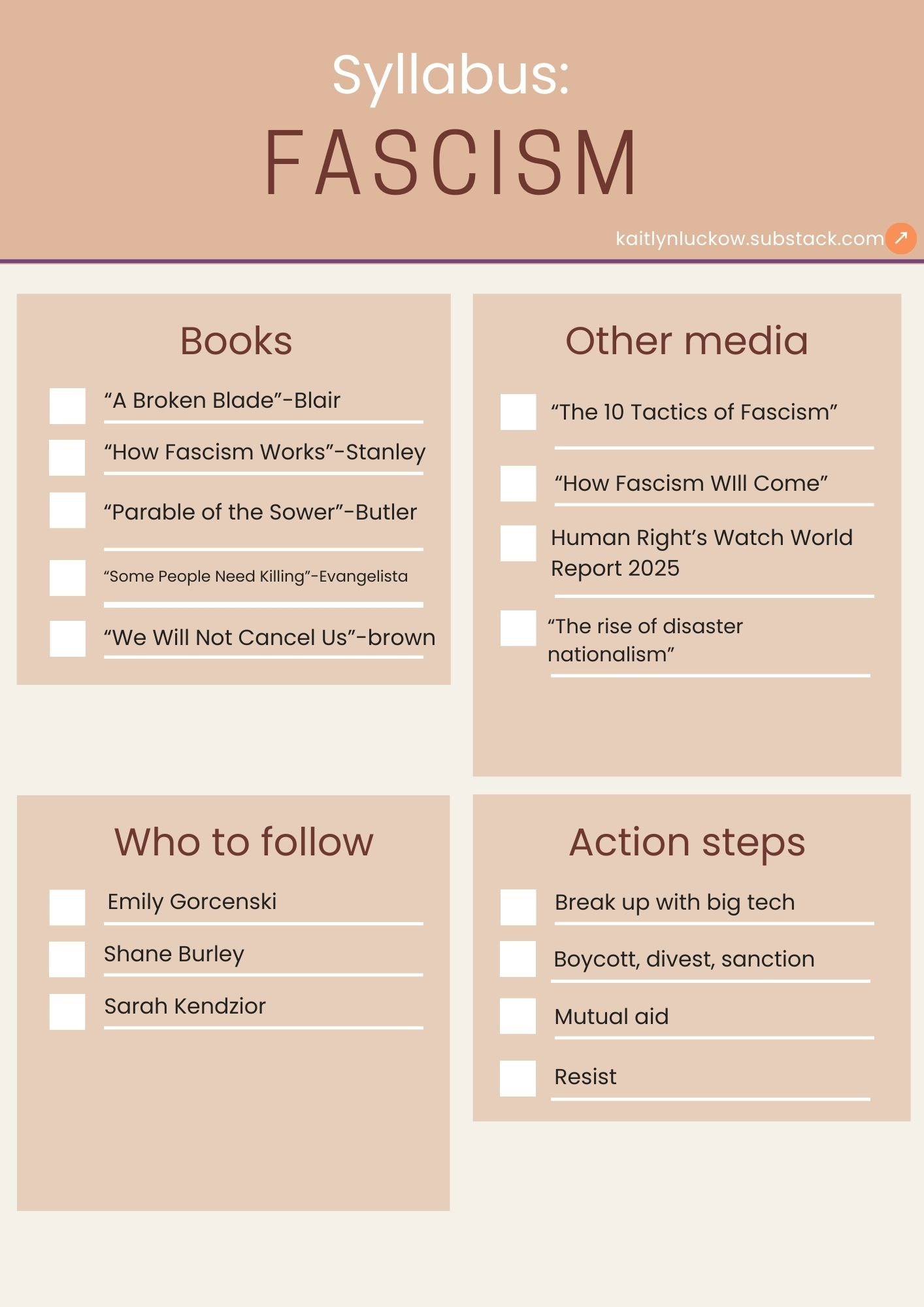Your fascism syllabus
Want to learn more about fascism? Here's a guide on where to start, how to increase your learning, and what to do about it all.
Welcome to my Syllabus Series. I was a high school English teacher for over five years and nothing gives me more joy than to help others learn something new. As someone who also reads a large amount of non-fiction, I wanted to create a new series where I pick a singular topic that you might want to learn more about. This edition is all about a timely topic that I know is on all of our minds: fascism.
This is the first syllabus I’ve made where I haven’t read all of the books I’m going to recommend to you. While I’ve read some, I’m like you and looking for answers. These recommendations come from other readers and organizers that I deeply trust. Let’s learn together.
In this syllabus, I’ll take you through books to read through various genres and the order you should read them in to scaffold and layer your learning. But learning isn’t all about reading, so I’ll also share video resources, shorter articles, and give you a list of people to follow on social media in order to stay up to date well beyond today. Finally, learning means nothing without action, so I will also provide you ways that you can do something with what you’re learning.
This isn’t meant to be overwhelming and is laid out in a way that it’s learning you have time for. Therefore, the list isn’t extensive and manageable. Of course, there’s always more learning to be done.
Books to read
A collection of books read to read. For the best learning experience, try to read the books in this order.
(*note: this section contains affiliate links)
Fantasy
“A Broken Blade” by Melissa Blair
Starting with a fantasy book to learn about fascism? You read that right. One of my favorite things about fantasy is its ability to mirror our world today in fantasy settings which helps a whole new audience of readers make connections and take real-life learnings away from a setting that is rooted in magic. Fantasy isn’t escapsim. In fact, good fantasy helps us see our own world in a new way. There were a few books I was contemplating putting here, but I wanted to share a more popular book that has a world that mirrors the genocide and forced assimiliation of Native Americans.Non-fiction
“How Fascism Works” by Jason Stanley
A perfect introdcution to not only fascist regimes throughout history, but how patterns of fascists roots have been present in the United States for more than a century. This book looks at the structures, patterns, and language used to foster this environment, particularily focusing on the “us” versuses “them” linguistic technique to instill fear and hate.Fiction
“Parable of the Sower” by Octavia E. Butler
Now that you have a general understanding of the characitsitcs of fascism, it’s time to head back into a fictional world that isn’t so fictional anymore. Written in 1993, this dystopian book paints a picture of a possible (and nearly accurate) 2024 where America struggles with greed, wealth inequality, and climate collapse.
Journalism
“Some People Need Killing” by Patricia Evangelista
A lot of times when we think of fascism, we think of WWII and it being a thing of the past. But, recognizing that it still very much exists in today’s world can help contextualize our current moment. This incredible piece of journalism reports on the Philippinne’s war on drugs in which the state murdered approximately 30,000 innocent civilians because they were “dangerous” “drug addcits”. The rise to power of Rodrigo Duerte and his use of language to instill fear is reminiscent of Trump’s current tactics.Non-fiction
“We Will Not Cancel Us” by adrienne maree brown
Once you’ve grasped a good understand of fascism, the question remains, what now? What can we do about it? I think this book has some answers. This is book that’s a great partner to read with “Mutual Aid” by Dean Spade that I’ve recommended in the past. While, I don’t think this book is perfect, I think it’s a hopeful look at movement-building in the face of fascism.
Other media to consume
YouTube video
"The 10 tactics of facism” by Big Think
If you don’t have time to read Jason Stanley’s book above, this is a nice and easy-to-understand summary of how fascism comes to be.Poetry
“How Fascism Will Come” by Terry EhretThis poem was written back in 2011 and is an eerie premonition of sorts.
Report
Human Right’s Watch World Report 2025
Every year, the Human Right’s Watch puts out a global report outlining human right violations in every country in the world, much of these a direct result of authoritarian and fascist governments. However, the theme of this report focuses on 2024 being “A Year of Reckoning” as people responded to and even sometimes rose up against these governments through protest in countries such as Bangladesh, Venezuela, and Georgia.Article
”The rise of disaster nationalism” by Richard SeymourSeymour published a book called “Disaster Nationalism” last year and this article serves as a brief look into his analysis on the rise of far-right movements around the world and what we can do about it. This is definitely one of the more complex (in terms of language) reads on this list, which is why it’s at the end.
.
Who to follow
When learning about a subject where community is key it’s important to find people to help you along the way. Here are a few people and organisations I encourage you to follow:
Emily Gorcenski: A former data scientist, Emily is very active on Bluesky and is consistently documenting far-right activities and tools to combat fascism, from an anarchist lens.
Shane Burley: Author and journalist who consistently writes about fascism in today’s world.
- : Author and journalist who has long covered authoritaian governments.
Take action
2025 has been a year of immense overwhelm and panic. Some people have turned this into feelings of hope and some of hopelessness. But one thing that I think most people are collectively feeling right now is anger. And this anger is important. Here’s how you can utilize this anger in ways that can collectively make a difference:
Break up with big tech
As we’ve seen over the years and even more egriously over the past year, big tech is planning a huge and contorlling role in today’s fascism. This includes Apple (and it’s participation in the human rights violations happening in the Democratic Republic of the Congo), Google (as well as Apple) changed “Gulf of Mexico” to “Gulf of America”, Facebook has long had a history of using censorship and not using censorship in order to support certain ideologies, and Elon Musk is self-explanatory at this point.
While we unfortunatley live in a world where big tech holds a strong monopoly, we can break up with these companies where we’re able to.
Boycott, Divest, Sanction
Speaking of breaking up, one of the best things you can do with your money right now is not spend it, especially when that money is supporting billionaires or companies who are directly contributing to facist leaders or situations that could create an environment for facism.
I highly recommend downloading the Boycat app that helps you make ethical shopping decisions. You can search for companies to see if they’re on the boycott list and even scan QR codes at the store. It also gives you recommendaitons for alternatives.
This may seem like a small thing, but BDS movements have literally toppled facism in the past. World-wide boycotts helped lead to the fall of apartheid in South Africa.
Participate in mutal aid groups and efforts
Listen, mutual aid is probably always going to be in my action list for all of my syllabuses. But, it’s especially important when it comes to fascism. Fascism feeds off of overwhelm and hopelessness. This is where fear breeds and hate grows. The best way to combat this is to take care of each other.
If you don’t know where to start, think of a topic that you’re deeply passionate about or something you see being destroyed or targeted by the government. Surround yourself and find a group who is passionate about keeping that certain law in place, organization in tact, right maintained, or people safe. Start organizing. Encourage others to do the same.
Big Door Brigade has a toolbox for starting a mutual aid project depending on what type of mutual aid you’re interested in.
Resist
I often end these syllabuses encouraging individuals to protest. But now, I’m going to ask you to resist. As I said earlier, violent systems don’t respond to simply protest. Resistance is necessary. So, resist where you’re able to. This is going to look differently for everyone dependant on their ability and access to safety. Take part in the actions above (these are all forms of resistance). And if you want to be more physically active in your resistance, I would recommend another book as an honorary mention to this list: “How to Blow Up A Pipeline” by Andreas Malm.
As I mentioned earlier, learning is an ongoing practice. If you would like more resources, don’t hesitate to reach out. And if you have any resources to add to this list, please add them to the comments below.
Cover photo by: Dominik Türk







